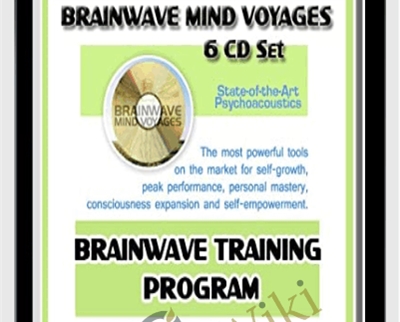Lost Negotiator Vault Tapes – Jim Camp
$21.00
Lost Negotiator Vault Tapes – Jim Camp Download. The only other way to get this material is to spend months tracking down and even outright nagging the Cam…
Salepage link: At HERE. Archive:
I’m Michael Senoff and I spent close to a year securing and negotiating for the rights to the late, great Jim Camp’s original trainings and teachings — which were recently re-discovered in the Camp Estate vaults on audio cassettes. These recordings from the mid 1980s are the “for real” secret and reveal Jim Camp at the top of his game. They are unlike anything I had heard before, including when I personally grilled Jim Camp on over 150 of his best methods in a Q&A program a decade ago.
There’s a reason why the FBI changed their negotiation protocols after learning Mr. Camp’s methods, and why his material has been required reading by the most prestigious and expensive business schools in the country. And these “lost” tapes — remastered on digital MP3 — contain his entire 18-part methodology he taught live to his elite private students.
The only other way to get this material is to spend months tracking down and even outright nagging the Camp Estate to sell them to you. But even then, you’ll have to pay $597 — while they have agreed to give me the exclusive rights to sell them at $97 for a very limited time.
That’s why the deadline to get them is Monday, May 27th at midnight PST.
HERE’S WHAT YOU GET
1. The System For Landing Clients That Starts With “No”:
– Part One contains a 14:03 minute audio and an accompanying 5-page transcript.
For the full description of each interview click here.
2. Exploding The “Yes” Myth
– Part Two contains a 22:15 minute audio and an accompanying 8-page transcript.
For the full description of each interview click here.
3. Why “Maybe” Is Never An Option: The Rules Of A Negotiation
– Part Three contains a 14:40 minute audio and an accompanying 7-page transcript.
For the full description of each interview click here.
4. How To Take Control Of Your Negotiations By Taking Control Of Your Behavior
– Part Four contains a 21:43 minute audio and an accompanying 8-page transcript.
For the full description of each interview click here.
5. The Little-Known Magic Of Showing You’re “Not Okay” In A Negotiation
– Part Five contains a 10:50 minute audio and an accompanying 5-page transcript.
For the full description of each interview click here.
6. The One Best Way To Control Emotions In A Negotiation While Creating Vision In Your Adversary
– Part Six contains a 20:30 minute audio and an accompanying 4-page transcript.
For the full description of each interview click here.
7. The Essential Scripts And When To Use Them
– Part Seven contains a 18:21 minute audio and an accompanying 7-page transcript.
For the full description of each interview click here.
8. The Secret To Being A Winner
– Part Eight contains a 24:36 minute audio and an accompanying 4-page transcript.
For the full description of each interview click here.
9. The Greatest Weakness In A Negotiation And How To Stop It
– Part Nine contains a 07:07 minute audio and an accompanying 4-page transcript.
For the full description of each interview click here.
10. How To Use Questions To Turn On The Discovery Channel
– Part Ten contains a 12:52 minute audio and an accompanying 4-page transcript.
For the full description of each interview click here.
11. How To Gain Control Of Negotiations By Being Quiet And Nurturing
– Part Eleven contains a 9:26 minute audio and an accompanying 6-page transcript.
For the full description of each interview click here.
12. The Weaknesses Of A Win-Win Negotiation Revealed In Real Time
– Part Twelve contains a 14:42 minute audio and an accompanying 5-page transcript.
For the full description of each interview click here.
13. The Essential Checklist For Every Negotiation
– Part Thirteen contains a 22:48 minute audio and an accompanying 5-page transcript.
For the full description of each interview click here.
14. Why You Absolutely Need A Mission And Purpose (And How To Create One)
– Part Fourteen contains a 23:13 minute audio and an accompanying 7-page transcript.
For the full description of each interview click here.
15. Taking Control Of Every Negotiation By Creating A Framework
– Part Fifteen contains a 33:39 minute audio and an accompanying 7-page transcript.
For the full description of each interview click here.
16. Be Ready For Your Next Negotiation By Logging Your Last One
– Part Sixteen contains a 27:59 minute audio and an accompanying 8-page transcript.
For the full description of each interview click here.
17. How To Turn Any Negotiation Around
– Part Seventeen contains a 53:57 minute audio and an accompanying 11-page transcript.
For the full description of each interview click here.
18. Eliminating The Wildcards In The Decision-Making Process
– Part Eighteen contains a 28:48 minute audio and an accompanying 9-page transcript.
For the full description of each interview click here.
19. Bonus Interview – Inside Jim Camp’s Mind From One of The Men Who Knew His Best. And interview with Copywriter David Garfinkle
– Part Nineteen contains a 52:48 minute audio and an accompanying 43-page transcript.
For the full description of each interview click here.
20. Bonus Interview – An Inside Look At What The Camp Group is Doing Now That Jim Camp Is No Longer With Us. And Interview with Todd Camp and Lead Negotiator David Desantis.
– Part twenty contains a 32:48 minute audio and an accompanying 23-page transcript.
For the full description of each interview click here.
21. Bonus Video – How elBenbo Has Used Jim Camp’s Negotiation Methods For The Last 11 Years To Blow Right Past His Most Successful Competitors
– Part Twenty-one contains a 86 minute video
For the full description of each interview click here.
HERE’S WHAT THE JIM CAMP ESTATE “LOST” NEGOTIATOR VAULT TAPES WILL DO FOR YOU
If you’ve ever lowered your price, lost a prospect or compromised on anything in your personal or professional life, these Jim Camp Estate “Lost” Negotiator Vault Tapes may change everything for you.
Hear Jim Camp live and teaching a group of professional his System of Negotiation. Jim teaches the fundamentals of negotiation mindset, behaviors, and structure over 18 sessions totaling 6 hours and 30 minutes.
The lessons are delivered in high-quality audio mp3 and include the transcripts of all the sessions. Additional downloads describe how to make a Mission and Purpose statement, pre-negotiation checklists and the post-negotiation log.
Download, listen to or read the transcripts to all 18 parts your Jim Camp Estate “Lost” Negotiator Vault Tapes
Then study and use his techniques and you’ll gain an understanding about the one of the most powerful life secrets known to man. How to negotiate winning agreements.
Your Jim Camp Estate “Lost” Negotiator Vault Tapes Detailed Descriptions Below
You’ll be able to immediately download your Jim Camp Estate “Lost” Negotiator Vault Tapes Instantly After Payment Is Received Which Includes . . .
1) The System For Landing Clients That Starts With “No”:
Jim Camp passed away a few years ago, but he will forever be remembered for his Negotiator System that teaches salespeople worldwide that landing clients can start with the word “no.”
Sales meetings and calls are just negotiations, and in any negotiation, you’re going to hear the word “no” a lot. Jim uses it as a jumping-off point. But you have to have a system in place before you do it.
When Jim was a young fighter pilot, he learned there were steps you could take in any given situation that would save your life, and if you practiced them enough in a safe environment, you would default to those steps when the going got rough. It’s the same with sales.
By developing habits within a tried-and-true system, you will have all the tools you need for successful negotiations. And in this audio, you’ll get a look at what those are and how to use them along with . . .
- How the comment “Sit down, stupid” from a major during Jim’s fighter pilot training changed Jim’s whole perspective of systems and helped him shape the principles of his negotiator one
- The “insider” secrets of using failure as a catalyst to success: exactly why it’s so important to allow yourself to fail in a no-risk situation, and how to do that
- The fastest known way to kick yourself into developing more effective habits in sales and in life
Jim says, when it comes to negotiations, the real problem we have begins with control.
Often times, our need to be in control makes our behavior out of control, essentially killing a sale before it’s even begun.
That’s why it’s so important to have that system in place and your behavior practiced.
And in part one, you’ll hear all about it.
– Part One contains a 14:03 minute audio and an accompanying 5-page transcript.
Click To Order
2) Exploding The “Yes” Myth
We’ve all been trained to love the word “yes.” We want to say it, hear it, and expect it as the only acceptable answer in a negotiation. That’s why in part two, you’ll listen in as Jim conducts a workshop with businesspeople that challenges their beliefs, while exploding this “must hear yes” myth.
According to Jim, “no” is just a decision. In fact, it’s the safest decision your adversary can make, so expect to hear it a lot. But, like any other decision, it’s one that can be changed. So it can actually be a good jumping-off point. And in part two, you’ll hear how to do that including…
- The single most important word in a negotiation – respect – what that means and what it doesn’t
- Examples of how your adversary will always mirror your behavior, and how to use that to get them to make a decision quicker (with no being a completely acceptable decision)
- The simple little lesson about negotiations you can take from the child who gets “no” from daddy, and then goes to mom
- The real reason it never works out when you try to take away someone else’s right to say no: Examples from history of people who have stolen that right or have had it stolen from them, and how that worked out
Because we’ve been trained to view “no” as a negative, when we hear it, it gets our emotions going and throws us off our game. But Jim says it’s not a rejection. It’s just a decision. Period. And in this audio, you’ll listen in as Jim uses the tools of his system to teach his system, while showing you the power of “no,” and where to take it from there.
– Part Two contains a 22:15 minute audio and an accompanying 8-page transcript.
Click To Order
3) Why “Maybe” Is Never An Option: The Rules Of A Negotiation
Jim says the most dangerous answer in any negotiation is maybe. When you allow your adversary to say “maybe,” you’re saving them from making a decision. And you’re not allowing them to see the real pain.
That’s why having a system in place is so critical.
We have been trained by habit to allow “maybes” in life when we shouldn’t. Jim says negotiations are one hundred percent emotional until a decision is made.
“No” is a valid decision, but “maybe” is not.
And in part three, you’ll hear all about that, and the other principles and rules that make up the Negotiator System including . . .
- The four levels of decision making and why Jim says it’s so important to remember you can’t have action without vision, what that means and how to frame your negotiations around it
- The simplest lesson to take from Japanese culture about effective negotiations and decisions
- The three books Jim had in his possession at the time of this workshop, and why you may want to pick them up too
- Examples from Vietnam of how training comes into play, keeping you calm in even the craziest of circumstances.
The good thing about having a system in place for negotiating is that when the going gets tough, you will calmly revert to the steps you’ve been trained for. And in this audio, you’ll hear all about them, including the importance of never letting maybe be your answer, or your adversary’s.
– Part Three contains a 14:40 minute audio and an accompanying 7-page transcript.
Click To Order
4) How To Take Control Of Your Negotiations By Taking Control Of Your Behavior
You may not realize it, but your behavior in a negotiation directly affects your adversary’s behavior.
That’s why, even before the negotiation begins, you have to train yourself, especially when it comes to knowing the difference between need-mode and want-mode. Because need-mode usually kills a negotiation.
Saying things to yourself like, “I need to make this sale,” “I need to call Jerry,” “I need to make three appointments,” causes your adrenalin to go up, your voice to rise into panic mode, and desperation to set in. And in part four, you’ll hear why this is so dangerous and how to keep yourself from doing it.
You’ll also hear . . .
- The shocking way we throw ourselves into need-mode even when the adversary says “yes” to us, along with the many other ways we show need in a negotiation and the simple strategies for taking back control
- A little known fact: There are only two kinds of activities in the world (pay-side activities and non-pay-side), the difference between the two, and how to use that concept to increase sales
- Exactly why Jim says you don’t win with action or reaction. You win with re-reaction: Here’s what that means and how to use it in a negotiation
- The most dangerous negotiation there is (the one you don’t know you’re in), how that can happen and examples of how to make sure it doesn’t
- The scary — and often overlooked — side of the “trick close” in sales (when you trick your adversary into signing on), and why Jim says just don’t do it
- The crazy place Jim says is his favorite place to do negotiations, and why.
As you go through the training in Jim’s Negotiator System, you’ll develop better habits like being more present and aware in negotiations.
You’ll realize when you go into need-mode and you’ll be able to turn it around fast. Want-mode is clear-thinking mode. And in part four, you’ll hear how to keep yourself there.
– Part Four contains a 21:43 minute audio and an accompanying 8-page transcript.
Click To Order
5) The Little-Known Magic Of Showing You’re “Not Okay” In A Negotiation
When we see someone being “not okay,” it makes us feel a little more okay about ourselves. It’s why we love soap operas. It’s why we try our best to help people less fortunate than we are.
It’s also why the first thing Jim does when he comes into a room is loosen his tie, unbutton his collar, and roll up his sleeves. It’s all part of the strategy Jim calls being not-okay on purpose.
Think about it. How many people like to be around a snooty know-it-all who tries to be perfect? Being not-okay breaks down barriers.
It makes you seem like a regular guy, and makes your adversary feel more at ease. And in part five, you’ll hear all about the little ways you can achieve being not okay and how to use it in your next negotiation.
You’ll also hear . . .
- The secret of how President Reagan used the not-okay concept in press conferences and meetings and why Jim calls him a master communicator
- A quick look at being not okay from your adversary’s perspective: How will it make them feel to be around you? How can you expect them to react? How would they react around a perfect person?
- The little lesson about not-okayness you can learn from the TV series Colombo
- Five simple ways you can show not-okayness at your next meeting Being not-okay doesn’t mean you’re being unprofessional or acting like a fool.
It simply means you’re using strategies to make your adversary feel more comfortable by making you seem more human and likeable.
And in this audio, you’ll hear all about it.
– Part Five contains a 10:50 minute audio and an accompanying 5-page transcript.
Click To Order
6) The One Best Way To Control Emotions In A Negotiation While Creating Vision In Your Adversary
Jim calls it the blank slate. It’s when you don’t think about anything else in a negotiation except listening.
No talking. Taking notes is good. Asking questions to clarify is okay. But you’re not assuming anything about your adversary.
You’re not wondering if you’ll make the sale, or trying to think of the next thing to say. The only thing you’re doing is being in your adversary’s world.
And in part six, you’ll listen in on another workshop with Jim where he helps businesspeople, like you, develop the kinds of tools that will help them see their
adversary’s picture.
You’ll also hear . .
- The single biggest reason we’re all trained to try to think of what to say next when we should be listening, and how to un-train yourself
- The only time you can get blindsided when you’re blank slating and how to prevent it
- An example about blank slating you can take from Joe Montana and a two-minute drill
- Three things that can kill your blank slate, even if you’re good at it
- Exactly what to do if you’re feeling tired or overwhelmed during a meeting and you’re not able to concentrate properly
Our ability to see the other person’s vision is critical to our success as a professional negotiator.
Expectation, fear and need all destroy our ability to open our mind to our adversary, which is why blank slating is such an important tool.
And in part six, you’ll hear all about it.
– Part Six contains a 20:30 minute audio and an accompanying 4-page transcripts.
Click To Order
7) The Essential Scripts And When To Use Them
Jim says there are two essential scripts we use as professional negotiators: the nurturing- parent script and the adult-with-information one. Although child scripts and critical parent scripts exist (and are good to recognize because your adversary may use them), you shouldn’t use them in your negotiations.
And the good news is once you’ve begun recognizing scripts, if an adversary says something like, “Don’t call me again. I’ll call you,” you’ll be able to take a step back, recognize that as a “critical parent” script that is basically telling you, “Children are seen but not heard,” and you won’t fall into the trap of responding with a child script.
If you instead respond with a nurturing parent or an adult-with-information one, you’ll be able to turn the negotiation back around and gain control again.
And in part seven, you’ll hear what this all means and how to do it. You’ll also hear . . .
- An in-depth look at each script: when and how we develop unhelpful scripts and how to change them
- How to deal with angry administrative assistants who seem to have critical parent down
- The real reason using the wrong script/tape can cause you to lose a deal, and how to make sure that doesn’t happen to you
- The “can’t miss” way to develop better scripts for yourself simply by listening to the natural way people respond in negotiations
- A word-for-word look at how to use strip-lines with your scripts to move a negotiation along, even when it seems to be going nowhere
- The key scripts to use when your adversary seems very excited about your product or service so you can bring them back to center, and why you definitely want to do that.
Jim says our ability to use nurturing parent and adult with information is critical to our success as professional negotiators. If you recognize the scripts, you can bring even the most out of control negotiations back to a realistic state.
And in this audio, you’ll hear all about them.
– Part Seven contains a 18:21 minute audio and an accompanying 7-page transcript.
Click To Order
8) The Secret To Being A Winner
According to Jim, there are three types of people in the world: winners, losers, and the average guys.
It’s probably no surprise that Jim says you should try to be a winner. But it might be surprising to know just how important that is in a negotiation.
In fact, Jim says it’s the most important part, probably because winners expect to win.
They take responsibility for their actions and behavior and they do everything to prepare themselves for a competition. But if they should lose, they look at it as a learning experience.
Losers blame everything on everyone else, and the average person just tries to get by on the least amount of effort. That’s why in part eight, you’ll hear all about the power that self-esteem plays in a negotiation, and how to make sure you go into yours with the best possible outlook. You’ll also hear…
- The little-known characteristics of a winner, and what Vince Lombardi really said about winning
- The demystifying truth about winning that you can learn from the kid playing Little League who thinks he’s the best, and doesn’t need to learn anything new
- The real reason why it’s so important to pay it forward in life
- A weird (but effective) way to view self image (the “I” and the “Our”), how predators attack our I (our individual self), and how to become immune to it
- Key strategies you can take from Neil Armstrong, John Glenn, and every fighter pilot who’s ever lost his or her perfect vision and had to make a role switch in life
- The secret of starting every competition the way Jack Nicklaus did in his day (He didn’t just show up at the golf course and expect to play well. He prepared months in advance)
Jim says we learn our roles growing up. Were we a smart baby or a slow one? Were we a good student or one who struggled at every turn? And we engrained those roles into our self-image today. The good news is, something learned can be relearned.
And in this audio, you’ll hear how you can start being a winner today and what a difference that can make in not only your negotiations in life, but in life itself.
– Part Eight contains a 24:36 minute audio and an accompanying 4-page transcript.
Click To Order
9) The Greatest Weakness In A Negotiation And How To Stop It
Jim says, when it comes to negotiations, making assumptions is one of the greatest weaknesses you can have.
Problem is, it’s also one of the hardest to quit because we’ve all been trained our entire lives to make assumptions, about everything from what the person we are talking to is going to say next to life itself.
That’s why in part nine, you’ll hear the real dangers in making assumptions, how they can mess up a negotiation, and how to stop making them. You’ll also hear…
- The crazy way school teaches kids to make assumptions, and what usually happens when they get things wrong
- The one way to eliminate assumptions that actually works
- A little-known fact: we use assumptions to fight for our “okay-ness.” Here’s why that almost never works out for us
- Examples of how assumptions have shaped the way we view history (Do you really know history or are you assuming things?)
The habit of making assumptions can definitely hurt us in a negotiation. But the good news is, we can break the habit.
It just takes practice and in this audio, you’ll hear how to do it.
– Part Nine contains a 07:07 minute audio and an accompanying 4-page transcript.
10) How To Use Questions To Turn On The Discovery Channel
Asking questions is one of the best ways to draw out your adversary’s pain and help them picture their world. But you can’t just ask any old question. In fact, Jim says there are two different kinds of questions: verb-led and interrogative questions.
You’ll use both, but interrogative questions are the ones you’ll want to use the most.
They start with who, what, where, when, why, how and sometimes which. When used correctly, Jim says they can turn the “discovery channel” on in your negotiation to help you find out valuable information, while keeping the conversation focused right where you want it to be – in your adversary’s world.
Here's an overview of the prominent keywords and a list of famous authors:
Business and Sales: Explore business strategies, sales skills, entrepreneurship, and brand-building from authors like Joe Wicks, Jillian Michaels, and Tony Horton.
Sports and Fitness: Enhance athleticism, improve health and fitness with guidance from experts like Shaun T, Kayla Itsines, and Yoga with Adriene.
Personal Development: Develop communication skills, time management, creative thinking, and enhance self-awareness from authors like Gretchen Rubin, Simon Sinek, and Marie Kondo.
Technology and Coding: Learn about artificial intelligence, data analytics, programming, and blockchain technology from thought leaders like Neil deGrasse Tyson, Amy Cuddy, and Malcolm Gladwell.
Lifestyle and Wellness: Discover courses on holistic health, yoga, and healthy living from authors like Elizabeth Gilbert, Bill Nye, and Tracy Anderson.
Art and Creativity: Explore the world of art, creativity, and painting with guidance from renowned artists like Bob Ross and others.
All the courses on WSOlib are led by top authors and experts in their respective fields. Rest assured that the knowledge and skills you acquire are reliable and highly applicable.
User Reviews
Only logged in customers who have purchased this product may leave a review.










![[ETA] Energetic Throat [Chakra] Activation - Rudy Hunter](https://wsolib.com/wp-content/uploads/2023/05/Rudy-Hunter-5BETA5D-Energetic-Throat-5BChakra5D-Activation.jpg)


There are no reviews yet.